Content [show]
It's hard to imagine a vegetable garden without a vegetable marrow. This vegetable is one of the first to be harvested and appears on tables in the form of various dishes. The ease of growing zucchini, availability, early maturity and other characteristics allow, with proper care, to grow these plants of various varieties in open ground, greenhouses and greenhouses in Siberia, Moscow region and in the Leningrad region.
Varietal variety of zucchini
Our grandmothers did not think much about the varietal characteristics of the plants grown and from year to year they collected their seeds from the best fruits. Sometimes a new variety appeared on the site, but its main characteristic was color spectrum fruits: white, green, yellow, etc. with
The arsenal of modern gardeners is much wider and the color scale as a sign has faded into the background. Attention is paid to such characteristics as:
- Ripening terms (early, middle, late);
- Growth type (bush, climbing);
- Pollination features (parthenocarpic or insect pollinated);
- Productivity.
These and other characteristics allow the rule to select a species for specific conditions and get the most out of each plant.
 To get a good harvest, you need to select a variety according to its characteristics.
To get a good harvest, you need to select a variety according to its characteristics.
Among the variety of zucchini, special attention should be paid to varieties that have earned the recognition of breeders and are most popular with gardeners. Each group has its own favorites. Someone is convenient due to their ripening time, and someone conquers with their compactness.
The best bush varieties for outdoor cultivation
Most asthenia of the Pumpkin family form long, spreading whipsthat require large areas. At the same time, modern summer residents and gardeners are often limited to 6 acres, on which they want to plant a variety of crops.
The limited space and savings of every meter make planting traditional climbing varieties a real luxury, but bushy ones become a godsend for such sites.
Bush squash you can easy to fit into tight spaces and even plant in a flowerbed among flowers, where large leaves will be an excellent backdrop for other plants.
Aeronaut
Compact plant. Shows good disease resistance.
Fruits are green, 14-15 cm long, tasty, versatile.They perfectly withstand transportation. Subject to the rules of agricultural technology from 1 sq. m of area can be collected 7-7.5 kg.
 Aeronaut
Aeronaut
White
Ultra-ripe... The first fruits are ready to be harvested within 35-40 days. Fruits of white color, oval, excellent taste, universal purpose The pulp is dense, creamy. Stores well.
 White
White
Waterfall
Early ripe hybrid. Fruits weighing up to 500 g, green. The pulp is dense, white. The yield is high. Disease resistance is above average.
Odessa
Early maturing bush type variety. Disease resistance is very high. The fruits are pale green, cylindrical. The pulp is pinkish yellow or light yellow. Suitable for canning.
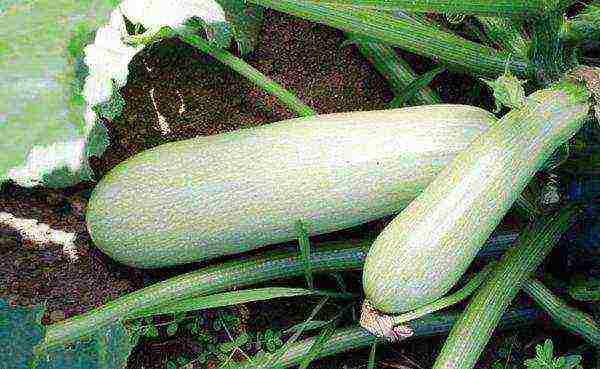 Odessa
Odessa
Best self-pollinated parthenocarpic species
Zucchini forms female and male flowers. In most cases, pollination and fruit setting occurs with the help of insectsthat carry pollen. However, when grown in greenhouses, especially in winter, cross-pollination is problematic.
Parthenocarpic varieties that are able to set fruits without pollination are becoming a real find. These varieties are also great for open ground.
Kavili
Early ripening and high yields make the Cavili hybrid one of the best.
Fruits are light green, up to 22 cm long. Fruiting is abundant and long-lasting. The ripening period is 1.5 months, and the active setting of new fruits takes place within 2 months in any conditions, even without any participation of pollinating insects. During this time, from 1 sq. m manage to collect about 9 kg... The pulp is tender, juicy, whitish.
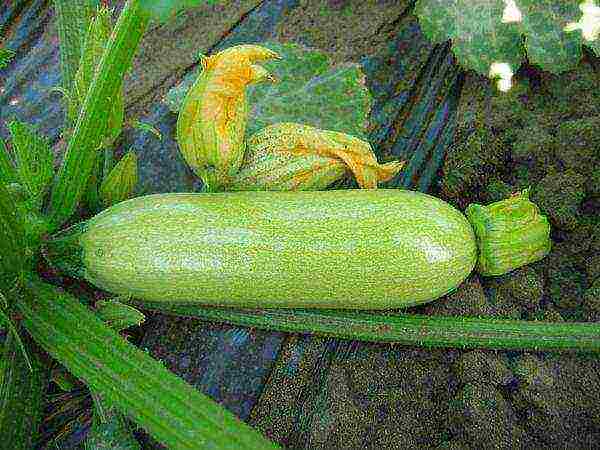 Kavili
Kavili
Jellyfish
Super early hybrid. Ideal for early production under cover films. Withstands large temperature changes.
Ripening period 35 days. The fruits are light green with a delicate skin. The pulp is dense, the seed chamber is miniature. Fruit weight can reach 800 g, with a length of 25 cm.
 Jellyfish
Jellyfish
Parthenon
A Dutch breeding hybrid, very compact and productive. For 1 sq. m you can place 3-4 bushes and collect up to 15 kg fruits. Good insect-free fruit set and early ripening make this variety an excellent candidate for greenhouse planting.
The fruits of the variety are dark green, cylindrical with light green dense, juicy and tasty pulp. It can be used not only for canning and preparing various dishes, but also eaten raw. Zucchini fruiting period very long and can stretch until September.
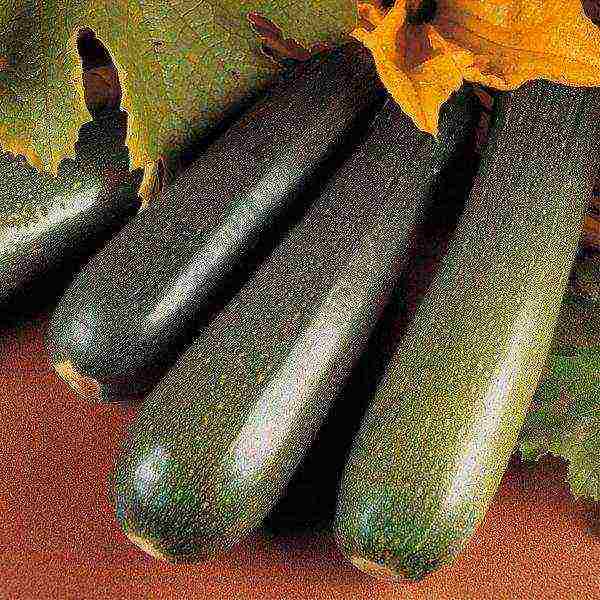 Parthenon
Parthenon
Early varieties
Zucchini varieties of early ripening are of particular value, because it is they who most often become the first fresh vegetables of the new summer season.
Iskander
An early ripe parthenocarpic hybrid bred by Dutch breeders. Ripening period 40-45 days.
The special value of the variety lies in its ability to set fruits at low temperatures, which is especially important for northern regions with cool summers.
When planting 4 plants per 1 sq. m yield is 15 Kg... Iskander fruits are light green, up to 20 cm long, with a thin delicate skin. The pulp is tender, juicy, creamy or white.
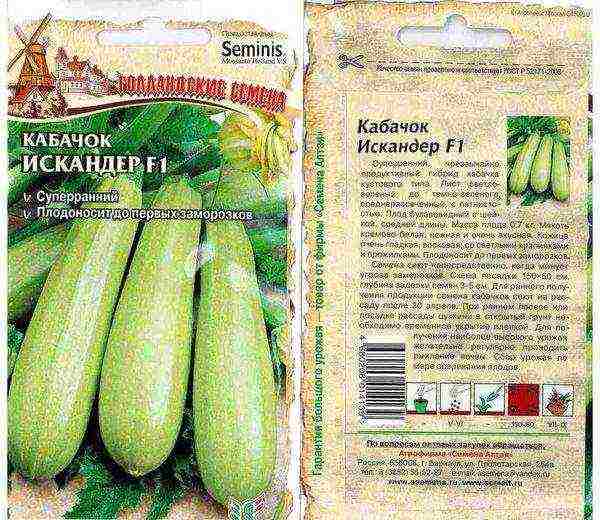 Iskander
Iskander
Tsukesha
The ripening period of the Tsukesha variety is 41-50 days. The plant is characterized by large dark green leaves with gray spots. These are varietal features of color and should not be confused with a disease.
Fruits up to 40 cm long and weighing up to 900 g. Fruiting continues until frost. Fruit well stored and transported... The pulp is juicy, very tasty.
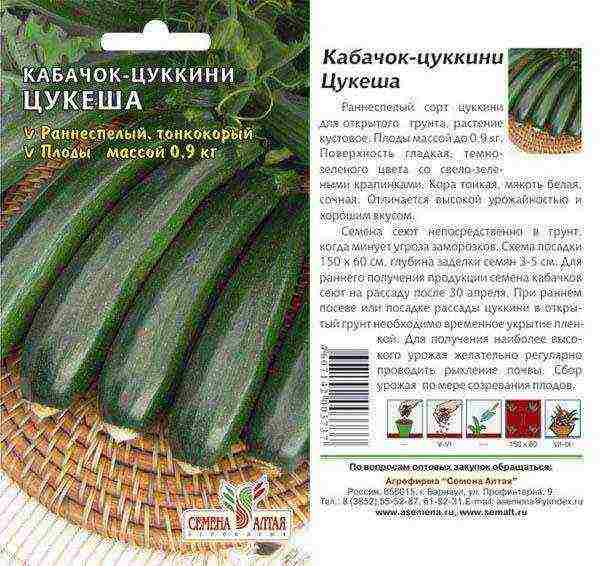 Tsukesha
Tsukesha
Ball
The main feature of the variety is green globular fruit covered with light dots that look like a ball. The pulp tastes excellent.
Ripening period for round squash is 50-55 days. The plant is compact, bushy with strongly dissected leaves.
 Ball
Ball
Aeronaut
This variety has already been mentioned as a popular bush squash, but the early ripening period is another plus in the piggy bank of positive characteristics. Ripening period 42-45 days.
Medium ripening
Gribovsky
The widely known white-fruited variety Gribovsky. Ripening period is not less than 46 days, depending on the region of cultivation. Plant forms long lashes.
Fruits up to 20 cm in size, white. The skin is hard, the flesh is tasty, white or yellowish. Yield 8.5KG from 1 sq. m.
 Gribovsky
Gribovsky
Zolotinka
Ripening period 50 days. Bush type of growth. The color of the fruit is fully consistent with the name.
 Zolotinka
Zolotinka
Black handsome
Bush grade. Ripens in 45 days. Fruits are very dark green in color, close to black. The peel is thin, the flesh is greenish, with a delicate taste.
The fruits are versatile and suitable for all possible uses. At the same time, 4-5 fruits can be tied on a bush.
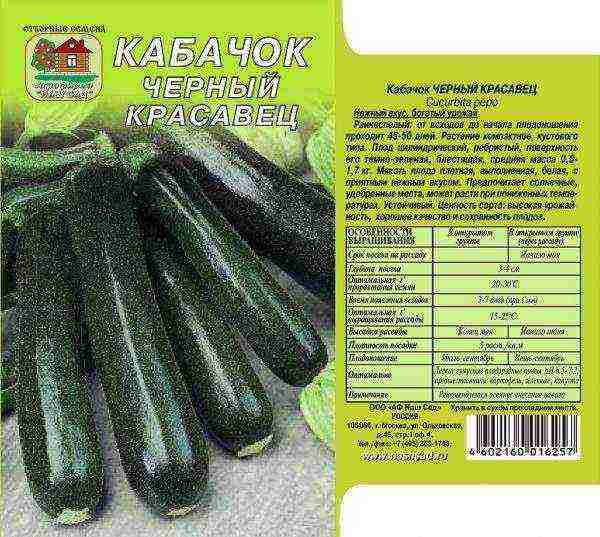 Black handsome
Black handsome
Late zucchini
Spaghetti
An unusual variety that is only gaining popularity.
Young zucchini Spaghetti tastes no different from the usual varieties, but after full ripening, the flesh of the zucchini stratifies into fibers and a peculiar kind is obtained. vegetable spaghettiwhich has many fans. Outwardly, ripe fruits resemble small melons in shape and color.
The only problem - late ripening, which in regions with a short summer does not always allow waiting for "macaroni".
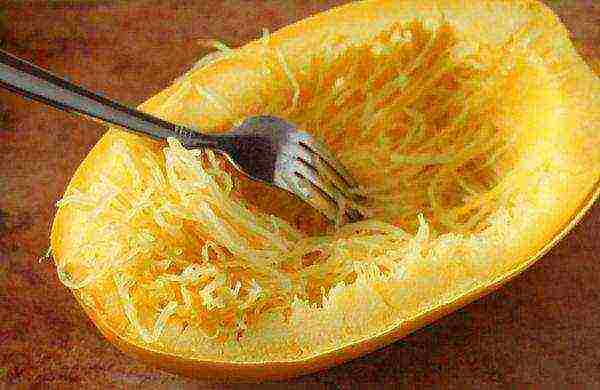 Spaghetti
Spaghetti
Lagenaria (Calabaza)
This type of pumpkin is also called Vietnamese zucchini... Due to the long ripening period and exoticism, lagenaria cannot be called a frequent visitor to vegetable gardens. The shape of the fruit varies.
When young, they are used as food in the same way as pumpkin or vegetable marrow. In a ripe state, the walls and pulp dry out and a cavity forms inside.
Traditionally, this plant was used by some peoples for the manufacture of vessels.
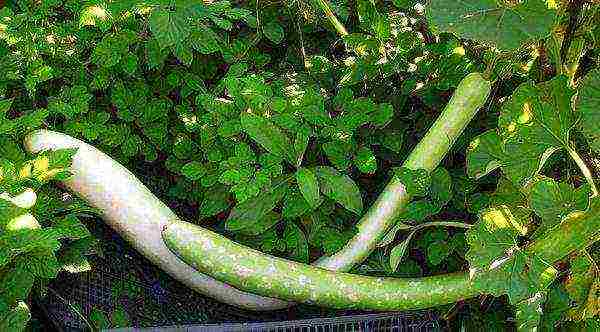 Lagenaria
Lagenaria
The variety of zucchini allows you to choose the right variety not only for certain growing conditions, but also for aesthetic and taste reasons.
With the right combination of hybrids, you can get a good harvest even from a small area and prolong the fruiting period. And some exotic varieties can help diversify traditional culinary dishes and grow craft materials.
Zucchini is one of the most favorite types of vegetables in summer cottages, they decorate the garden and grow well even among novice gardeners. The modern variety of species, varieties and hybrids of this culture allows you to achieve good yields even in regions of unstable agriculture.
The most popular and productive zucchini - names and descriptions
Modern varieties and hybrids of zucchini differ in the shape and color of the fruit, the type of growth, the characteristics of fruiting and the rate of ripening of the crop.
Bush squash
Usually, bush varieties mean exactly those that grow in a compact bush with a stem of no more than 20-30 centimeters. But sometimes short-leafed varieties are also referred to as bush, forming from one to three lashes up to 1 meter long. The smallest bush without lateral lashes in the varieties Rolik, Yakor (these two varieties also give few leaves), Tsukesha, Zebra, Yellow-fruited. The Zolotinka and Pharaoh varieties often form short strings of half a meter. The Dutch hybrids Iskander F1, Sangrum F1, Kavili F1 also belong to the bush type. Of the spaghetti zucchini group, the most compact bush is in the Russian spaghetti variety, the other varieties of this type give lashes a meter or more.
Shrub varieties of zucchini take up little space
With an excess of nitrogen fertilizers, all varieties of zucchini form lush tops to the detriment of fruiting.
If the zucchini bush forms too many leaves, the oldest of them can be removed without harm to the plant by cutting off at the base so as not to interfere with caring for the plant and collecting fruits. First of all, damaged leaves and those in contact with the ground are removed.
Dutch marrow
Many gardeners seek to purchase the advertised seeds of Dutch zucchini selection. However, such seeds, especially hybrids of the first generation (denoted by F1 symbols after the name or in front of it), are much more expensive than ordinary ones, and in terms of yield they do not differ much from the best Russian varieties. In addition, Dutch zucchini are more capricious. For normal growth and high yields, they need:
- well-cultivated fertile soil with a deep arable layer and a high humus content;
- uniform moisture;
- stable warm weather without sudden temperature changes.
Among the Dutch hybrids, the most popular in Russia are Iskander F1, Sangrum F1, Kavili F1.
Iskander F1
An early ripening hybrid (about 38–40 days from germination to harvest). Plants of compact bushy form. Leaves are medium and large, medium dissected, green with white spots. Fruits are club-shaped, light green with a light speck, medium-sized, weighing about 0.7 kg, very tasty. Typical yields are 6–9 kg per square meter.
Zucchini Iskander F1
Sangrum F1
An early ripening hybrid (about 38–40 days from germination to harvest). Plants of compact bushy form. The leaves are small or medium, strongly dissected, dark green with highly visible whitish spots. Fruits are cylindrical, light green with whitish specks, medium-sized, weighing 0.5–0.7 kg, very tasty. Fruiting is amicable. Typical yields are 4–5 kg per square meter.
Zucchini Sangrum F1
Cavili F1
An early ripening hybrid (about 40–42 days from germination to harvest). Plants of compact bushy form. The leaves are small or medium, strongly dissected, dark green with white spots. Fruits are cylindrical, whitish or light green, speckled, medium-sized, weighing 0.4–0.7 kg, very tasty. Fruiting is amicable. Typical yields are 4–5 kg per square meter. Under stressful conditions (hot or rainy weather, lack of pollinating insects) it is capable of partial pertenocarp - the formation of a certain number of fruits without pollination. Recommended for growing in garden plots and in personal subsidiary plots in all regions of Russia.
Zucchini Cavili F1
Partenocarp in zucchini
In crop production, there are several similar terms, confusion in which often leads to various misunderstandings:
- Self-pollination - fruits are formed when pollen is transferred from the stamens to the pistil within one flower. Self-pollinated zucchini does not exist in principle, they have male and female flowers separately.
- Self-fertility is the ability to form fruit when pollinated with pollen from the same plant. In all zucchini, self-fertility is rather low, so it is advisable to have at least two plants on the site for cross-pollination, especially when growing exotic species (lagenaria, muscat) that are not pollinated by ordinary zucchini.
- The female type of flowering means that more female flowers are formed on the plant than male ones (for example, in the varieties Anchor and Pharaoh). Pollination takes place in the usual way. If all flowers are only female, pollination and fruit formation will not occur.
- Parthenocarp is the ability of a plant to set fruit without pollination at all. In everyday conversation, under "self-pollinated" or "self-fertile" zucchini mean precisely parthenocarpic varieties.
Female (with ovary) and male flowers in a squash are easily distinguished already in buds
Parthenocarpic zucchini are very rare. As of June 2017, reliable official sources note the manifestation of parthenocarp (and then only partial) only in the Dutch hybrid Cavili F1. The old archives of gardening forums (2008–2011) mention the then parthenocarpic hybrid Parthenon F1 with dark green fruits, produced by the same Dutch company.However, now the seeds of the Parthenon F1 hybrid are not produced, information about it is absent even on the Dutch manufacturer's website. It was excluded from the State Register of Breeding Achievements approved for use in the Russian Federation more than 6 years ago. Accordingly, there are no real high-quality seeds of this hybrid on sale now. They sell either the remnants of old seeds that have lost their germination, or even a re-grading of unknown origin.
The best high-yielding Russian varieties
Russian breeders have created excellent varieties of zucchini, ideally adapted to the difficult soil and climatic conditions of different regions of Russia. In terms of yield, these varieties are not inferior to fashionable Dutch hybrids, comparing favorably with them in less capriciousness. Many of the Russian varieties are relatively cold-resistant, maintaining normal growth and development during long periods of cool weather with temperatures around +10 .. + 15 ° C.
There are no frost-resistant zucchini. At a temperature of -1 ° C, absolutely all varieties die.
Video clip
Very early ripening variety (about 32–38 days from germination to harvest). Plants are very compact, bushy, with few leaves. Leaves are not dissected, green without spotting. Fruits are cylindrical, weighing 0.7-1.3 kg, tasty. The color of the fruit is whitish-greenish at the ripening maturity, white when the seeds are ripe. Typical yields are 6–8 kg per square meter. The most hardy and cold-resistant variety. Recommended for northern regions.
Zucchini Roller
Anchor
Early ripening variety (about 37-40 days from germination to harvest). Plants are very compact, bushy, with few leaves. Leaves are not dissected, green without spotting. Fruits are cylindrical, slightly tapering towards the stalk, weighing 0.7-1.2 kg, tasty. The color of the fruit is whitish-greenish when the seeds are ripe, yellow when the seeds are ripe. Typical yields are 7–10 kg per square meter. A variety with a predominance of the female flowering type. Not resistant enough to disease.
Zucchini Anchor
White-fruited
Early ripening variety (about 36–44 days from germination to harvest). Plants are bushy. Leaves are not dissected, dark green with clearly visible white spots. Fruits are cylindrical, slightly ribbed at the base, weighing 0.7-1.1 kg, tasty. The color of the fruit is whitish-greenish when the seeds are ripe, white or yellow when the seeds are ripe. Typical yields are 7–10 kg per square meter. Insufficiently resistant to fruit rotting.
Zucchini Beloplodny
Tsukesha
Early ripening variety (about 40–45 days from germination to harvest). Plants are bushy. The leaves are large, dissected, dark green. Fruits are dark green with small specks, cylindrical, with a slight narrowing at the stalk, weighing 0.8-1.1 kg, very tasty. Typical yields are 11–12 kg per square meter.
Tsukesh zucchini
Pharaoh
Early ripening variety (about 39–43 days from germination to harvest). Plants bushy or semi-plaited form, form 1-2 lashes no more than 50 cm long. Leaves are medium in size, dark green, sometimes with faintly visible white spots. Fruits are cylindrical, dark green with small specks, weighing 0.8–1 kg, very tasty. A variety with a predominance of the female flowering type. The usual yield reaches 6-9 kg per square meter, under temporary film shelters up to 15 kg. Possesses relative cold resistance and increased resistance to fruit decay. Large ripe fruits can be stored in a cool room until March.
Zucchini Pharaoh
zebra
Early ripening variety (about 40–45 days from germination to harvest). Plants are bushy. Leaves are medium and large, green, strongly dissected. Fruits are cylindrical, dark green with pronounced longitudinal light green stripes and uneven spotting, medium-sized, weighing 0.9–1.2 kg, very tasty.The usual yield is about 7 kg per square meter. Zoned in the Central Black Earth region for personal subsidiary plots and garden plots.
Zucchini zebra
Table of comparative characteristics of varieties with white and green fruits
Unusual exotic zucchini
Zucchini varieties with yellow fruits are very popular among amateur gardeners. They are slightly more thermophilic than conventional varieties.
Yellow-fruited
Russian early ripening variety (about 40-50 days from germination to harvest). Plants are bushy. The leaves are large, strongly dissected, dark green. Fruits are bright yellow (sometimes two-colored yellow-green fruits are formed on some plants), cylindrical, with some narrowing towards the stalk, weighing 0.7-1.4 kg, very tasty. Typical yields are from 5 to 12 kg per square meter.
Zucchini Yellow-fruited
Zolotinka
Russian early ripening variety (about 40-50 days from germination to harvest). Plants bushy or semi-plaited form, form 1-2 lashes no more than 50 cm long. Leaves are medium in size, dark green with weakly pronounced white spots, strongly dissected. Fruits are cylindrical, bright golden-yellow, weighing 0.6-1.3 kg, very tasty. Typical yields are 5–7 kg per square meter. Recommended for cultivation in garden plots and in personal subsidiary plots in all regions of Russia.
Zucchini Zolotinka
Krukneki
In foreign countries, crooknek zucchini with original fruits curved at the base are very popular. Fruits are usually yellow in color of varying intensity, with smooth or bumpy skin. There are no zoned commercial varieties of this group in Russia yet; for amateur plots, the Russian bush variety Golden scallop with lumpy fruits weighing 1.5-2 kg, ripening for harvesting 60-65 days after germination, is offered.
Zucchini-kruknek Golden scallop
F1 Festival
A very original hybrid with almost round ribbed fruits of a variegated color. In Russia, due to a misunderstanding, it is referred to as zucchini, although in all foreign catalogs such varieties belong to the hard-bore pumpkin of the Acorn variety type. These plants are usually short-leaved, medium to medium late ripening.
Zucchini-pumpkin Festival F1
Ball
Russian variety with a medium early ripening period (about 50–55 days from germination to harvest). Plants are bushy. Leaves are medium, dissected, light green with white spots. Fruits are round, light green speckled, weighing 0.7-1.8 kg, very tasty. Typical yields are 4–11 kg per square meter.
Zucchini Ball
Boatswain F1
Russian hybrid of early ripening (about 44–46 days from germination to harvest). Plants are bushy. Leaves are medium, strongly dissected, green with white spots. Fruits are almost spherical, dark green, weighing 0.7–2.4 kg, very tasty. Typical yields are 6–10 kg per square meter.
Zucchini Boatswain F1
Spaghetti squash
A fashionable and original group of varieties with unusual fruit consumption. Fully ripe fruits are cut in half, peeled from seeds and baked whole in the oven for 20-30 minutes, as a result, their pulp breaks down into separate fibers, similar to pasta-spaghetti.
Ripe spaghetti zucchini, when baked, crumbles into fibers
Unripe fruits do not form fibers, they are used as the most common zucchini.
Most varieties of this type are climbing plants with late maturing (80–100 days) broad-oval cream or pale yellow fruits weighing 1–2 kg. The smallest and earliest in this group is the Russian Spaghetti variety. Its beautiful yellow-green fruits weighing about 0.6-0.8 kg ripen in 60-75 days, and the average yield reaches 6-7 kg per square meter, this variety is recommended for growing in garden plots throughout Russia.
Russian spaghetti - the earliest and most compact variety from the spaghetti zucchini group
Nutmeg (Walnut, Pear-shaped) zucchini
Also, due to a misunderstanding, short-leaved varieties of butternut squash are sometimes ranked as zucchini. They have pale orange-cream fruits of a very characteristic pear-shaped shape, slightly ribbed or smooth, weighing 1–2 kg, with bright orange flesh. These are very thermophilic plants that grow normally only at temperatures above + 25 ° C. The earliest of these varieties take at least 80–90 days to mature. They bear fruit well only in the southern regions.
Nut and Pear-shaped zucchini varieties - varieties of heat-loving butternut squash
How to get small zucchini
The only way to get small zucchini with underdeveloped seeds is to pick the fruit set on time, at least 2-3 times a week, this also contributes to a significant increase in yield. The expression "fruits do not outgrow" found in catalogs means one of two things:
- even relatively long fruits, half a meter long, retain a thin skin for a long time, seed development begins very late (most green and yellow zucchini zucchini);
- the growth of fruits in length quickly stops, the fruits remain short, but at the same time seed development and hardening of the skin begin early in them (white and round-fruited varieties).
To make the zucchini small, they are harvested 2-3 times a week
General principles of cultivation
Zucchini seeds are sown in a well-fertilized garden bed (a bucket of humus or half a bucket of manure per 1 square meter) after the end of the spring frost, when the soil warms up to + 20 ° C. Sowing dates are from late April in the south to early June in the north. Under the film, you can sow 1-2 weeks earlier. The sowing distance is 70–90 cm, the sowing depth is 2–5 cm. 2–4 seeds are sown in each hole to leave 1–2 best plants later. Excess seedlings are carefully cut at the root, so as not to damage the root system of the remaining plants during pulling out.
Sow several seeds in one hole to leave 1–2 best plants
When sowing directly into the ground, zucchini grows more powerful and healthy, with a deep root system, they can more easily withstand drought and cold weather, therefore direct sowing is always preferable to growing seedlings.
When watering, they moisten only the ground around the plants, preventing water from getting on the leaves and fruits
During the season, a garden bed with zucchini is regularly weeded from weeds, the soil is loosened and, if there is a lack of rain, a bucket of water is watered for each planting place. When watering, only the soil around the bushes is moistened, preventing water from getting on the leaves and fruits.
Video about growing zucchini in the open field
Novice gardeners are often mistaken, mistaking the natural spotted color of the leaves in some varieties for a manifestation of the disease. It's actually quite easy to tell them apart:
- natural color - uniform on old and young leaves, without signs of drying out;
- downy mildew - starts with old leaves, disorderly yellow spots and dry edges;
- powdery mildew is a white, washable powdery coating on the leaf surface, with clearly visible pinpoint foci.
How to distinguish natural leaf spot from disease (photo gallery)
If the disease manifests itself at the end of the season, no special treatments are required; with the early development of the disease, you can spray it with Strobi. On the infected site, any crops are grown next year, except for zucchini, pumpkin, cucumbers and lettuce. Zucchini do not have any special pests.
Features of agricultural technology and the choice of varieties for different regions
Depending on the climatic conditions, the cultivation of zucchini in different regions has its own characteristics.
South of Russia and South of Ukraine
Summers are long, hot, and often dry. When watering 1-2 times a week, zucchini of absolutely any species and varieties grow beautifully.To preserve moisture in the soil, it is advisable to mulch with any available materials - wood chips, nutshells, black agrofibre.
Mulching with wood chips helps to retain moisture in the soil
In extreme heat, the leaves of zucchini often droop even with sufficiently moist soil, especially in varieties with wide soft leaves. Cultivars with tough, split leaves tolerate heat more easily.
Middle zone of Russia, north of Ukraine, Belarus
In the open field, any varieties grow well, except for Muscat and Lagenaria, which succeed only in the warm summer. In cold spring, for early sowing, the bed is covered with a film in advance of a week so that the soil warms up well. Watering is necessary in dry summers.
In cold spring, the beds for zucchini are covered with a film a week before sowing, so that the soil warms up
Southern Urals, southern Siberia
Summers are short, but hot and dry, with sharp temperature changes. When watering 1-2 times a week, most varieties grow successfully, except for nutmeg and lagenaria.
North and north-west of Russia (including the Leningrad region), northern and central parts of the Urals and Siberia
Summers are short, cool, cloudy and rainy. Early cold-resistant varieties can bear fruit outdoors. It is advisable to cover with a film in the spring when sowing. In autumn, you can also protect from frost by placing arcs and stretching the film. Late and thermophilic varieties, even in a greenhouse, yield only in favorable years.
A simple cover made of arches with a stretched film will protect against spring and autumn frosts
Lagenaria - Vietnamese handsome
Lagenaria (Vietnamese zucchini, Indian cucumber, gourd, calabash, dish or bottle gourd) is a very distant relative of zucchini, an annual tropical liana up to 10 meters long. It is very thermophilic and grows well at temperatures not lower than + 20 + 25 ° C. Young fruits are edible, like zucchini.
Young fruits of long-fruited lagenaria are used for food, like ordinary zucchini.
Lagenaria seeds are sown one at a time in peat pots one month before the end of the frost. For normal pollination, you need to grow at least two plants.
Lagenaria seeds have a very hard shell, so it is better to germinate them before sowing.
Before sowing, it is advisable to germinate the seeds by wrapping them in a damp cloth and folding them in a warm place. As soon as the root hatches a little, it's time to sow.
Lagenaria seedlings are grown in peat pots
They are transplanted to a permanent place after the end of the frost and the establishment of warm weather. It is best to plant in the ground near the southern wall of the house, pulling a thick wire for support. The distance between plants is about 1 meter. The planted seedlings are covered with agrofibre during the first days. In warm weather, lagenaria grows very quickly, forming a mass of leaves similar to pumpkin.
Lagenaria leaves look like pumpkin leaves, but flowers are white and open at night
The white flowers of Lagenaria open only at night and are pollinated by moths. Artificial pollination is recommended for reliability. Pollen from male flowers is transferred to female flowers with a brush or directly from flower to flower. It does not pollinate with other pumpkin seeds.
For reliability, Lagenaria flowers are manually pollinated
The ovaries of the lagenaria are covered with dense pubescence. A part of a young growing fruit can be cut off, and after that it will continue to grow. In the long-fruited variety, the fruits reach 2 meters in length.
Only a few ovaries will grow into large fruits, the rest will dry out and fall off
During the ripening process, the fruits harden and dry out.
There is also an inedible lagenaria with pitcher-shaped bitter fruits.
Lagenarii jug-shaped fruits are used for various crafts. There are many inedible varieties among such varieties!
Its ripe dried fruits are used for various handicrafts, vases, utensils for mate.
Ripe dry fruits of lagenaria are used to make utensils for mate
Even in difficult climatic conditions, you can get excellent yields of zucchini with an adequate choice of variety and competent agricultural technology. And in the southern regions favorable for this culture, any species and varieties, even the most capricious, bear fruit perfectly.


